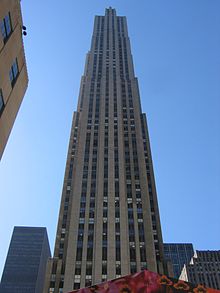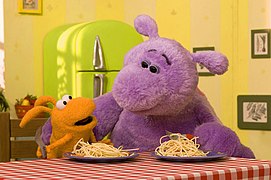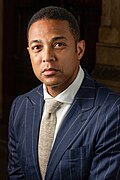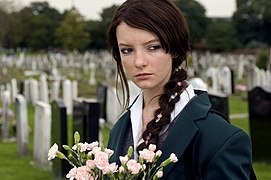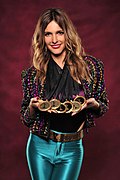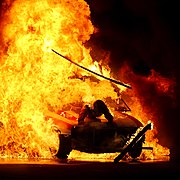Northamerica1000 (talk | contribs) Font layout |
Northamerica1000 (talk | contribs) update: max=62|subpage=Selected article |
||
| Line 13: | Line 13: | ||
|1 = |
|1 = |
||
{{Box-header colour|Selected article {{#if: {{{Purge|}}}{{{purge|}}} | {{{Purge|}}}{{{purge|}}} |- {{purge|<small>{{color|darkblue|''show another''}}</small>}}}}}} |
{{Box-header colour|Selected article {{#if: {{{Purge|}}}{{{purge|}}} | {{{Purge|}}}{{{purge|}}} |- {{purge|<small>{{color|darkblue|''show another''}}</small>}}}}}} |
||
{{Transclude random subpage|max= |
{{Transclude random subpage|max=62|subpage=Selected article}} |
||
{{Box-footer}} |
{{Box-footer}} |
||
Revision as of 15:30, 31 March 2022
The Television Portal

Television (TV) is a telecommunication medium for transmitting moving images and sound. Additionally, the term can refer to a physical television set, rather than the medium of transmission. Television is a mass medium for advertising, entertainment, news, and sports. The medium is capable of more than "radio broadcasting", which refers to an audio signal sent to radio receivers.
Television became available in crude experimental forms in the 1920s, but only after several years of further development was the new technology marketed to consumers. After World War II, an improved form of black-and-white television broadcasting became popular in the United Kingdom and the United States, and television sets became commonplace in homes, businesses, and institutions. During the 1950s, television was the primary medium for influencing public opinion. In the mid-1960s, color broadcasting was introduced in the U.S. and most other developed countries.
In 2013, 79% of the world's households owned a television set. The replacement of earlier cathode-ray tube (CRT) screen displays with compact, energy-efficient, flat-panel alternative technologies such as LCDs (both fluorescent-backlit and LED), OLED displays, and plasma displays was a hardware revolution that began with computer monitors in the late 1990s. Most television sets sold in the 2000s were flat-panel, mainly LEDs. Major manufacturers announced the discontinuation of CRT, Digital Light Processing (DLP), plasma, and even fluorescent-backlit LCDs by the mid-2010s. LEDs are being gradually replaced by OLEDs. Also, major manufacturers have started increasingly producing smart TVs in the mid-2010s. Smart TVs with integrated Internet and Web 2.0 functions became the dominant form of television by the late 2010s. (Full article...)
Selected article -
Selected image -
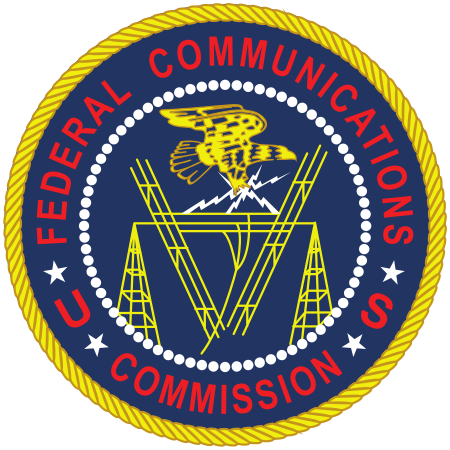
The Federal Communications Commission (FCC) is a United States government agency, created, directed, and empowered by Congressional statute (see 47 U.S.C. § 151 and 47 U.S.C. § 154), and with the majority of its commissioners appointed by the current president. The FCC was established by the Communications Act of 1934 as the successor to the Federal Radio Commission and is charged with regulating all non-Federal Government use of the radio spectrum (including radio and television broadcasting), and all interstate telecommunications (wire, satellite and cable) as well as all international communications that originate or terminate in the United States.
Did you know -
- ... that Angeline Quinto became the first Filipino singer to release a soundtrack album for a television series that featured a single artist?
- ... that among the special events broadcast by the Maine Television Network during its brief existence were a fashion show, a basketball tournament, and an ordination ceremony?
- ... that CBS News and Stations president Wendy McMahon helped bring local evening news back to the network's Detroit station after 20 years?
- ... that radio station KWKC dropped its application for a TV station in order to speed the arrival of television to Abilene, Texas, which would otherwise have been 89th in line?
- ... that the exclusive secret society Hamilton House from the television show Gossip Girl was based on St. Anthony Hall, a social and literary fraternity?
- ... that the European version of the video game Tomba! uses the theme song of the television series No Sweat as its opening theme?
Selected quote -
More did you know
- ...that the Simpsons short Good Night aired April 19, 1987 on The Tracey Ullman Show and was the first ever appearance of the Simpson family on television?
- ...that one of the television advertisements from the Good things come to those who wait Guinness advertising campaign was voted the "Best ad of all time" by the British public?
- ...that the ABC television network created controversy when they licensed and produced a doll based on fictional rapist Todd Manning?
- ..that the time traveling premise featured in the Chrono series of video games was inspired by such television programs as The Time Tunnel?
- ...that Ralph "Petey" Greene overcame a drug addiction and prison sentence to become an Emmy Award-winning radio and television talk show host and a guest at the White House?
Selected biography -
Thomas John Brokaw (/ˈbroʊkɔː/; born February 6, 1940) is an American retired network television journalist and author. He first served as the co-anchor of The Today Show from 1976 to 1981 with Jane Pauley, then as the anchor and managing editor of NBC Nightly News for 22 years (1982–2004). In the previous decade he served as a weekend anchor for the program from 1973 to 1976. He is the only person to have hosted all three major NBC News programs: The Today Show, NBC Nightly News, and, briefly, Meet the Press. He formerly held a special correspondent post for NBC News.
Along with his competitors Peter Jennings at ABC News, and Dan Rather at CBS News, Brokaw was one of the "Big Three" U.S. news anchors during the 1980s, 1990s and early 2000s. All three hosted their networks' flagship nightly news programs for more than 20 years. (Full article...)



























